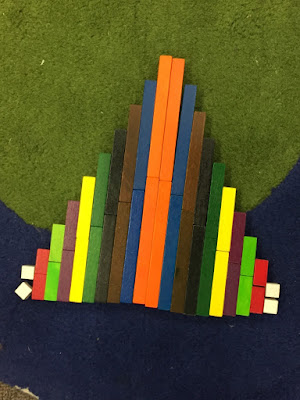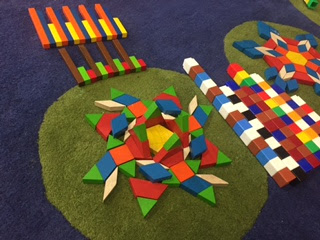We have been exploring the inspirational PASMAP program in our class this year. We have tried lots of great ideas and this has formed the basis of our focus on patterns.
A huge thank you to Jo Mulligan and Michael Mitchelmore.
This is the book that has been my inspiration this year.
It is available from ACER.
No - I am not on commission. Wish I was.
So one of the tasks that PASMAP uses is called "border patterns". Students are given an outline of a shape with pre-drawn squares on which they can place Unifix cubes to make patterns.
Sounds simple. Genius often does.
We had made patterns like this before but I was interested to revisit the task and change a few of the variables.
When we did this previously, we had made AB patterns or ABB patterns.
This time I wanted to increase the number of colours to 3 and not specify the length of the unit of repeat. What would the kids do?
Task - Use 3 colours to make a repeating border pattern around this shape.
Yep - can do. Easy.
Here is what happened.
So the students leapt into action. Soon we had cubes and blocks happening.
And then came that awful moment of realisation -
"Hey, I can't do it."
"I wonder why? What can I change?"
"Look - your pattern has 2 oranges next to each other."
"Nope - that won't work either."
So, ABC didn't work. AABBCC didn't work either. This student found a solution using AABBC.
Nice thinking.
Can you do it a different way?
And this one is AABCB. A nice variation.
So I asked about the "unsuccessful" borders. Why can't you make a ABC pattern or AABBCC pattern around this border?
One student soon realised that this border required 10 cubes so the unit of repeat couldn't be 3, like in ABC.
"Because 10 is not in the 3 times tables. If I count by 3, I will never say 10."
And from that idea, we soon agreed that the unit of repeat would need to be 2 or 5 (the factors of 10). But since we had to use 3 colours, then we would need to make a unit of repeat that was 5 cubes long - such as AABBC or AABCB etc.
Moving on, we looked at the second border on the page.
Same rules - use three colours and make a repeating border
The first thing the students did was count how many squares were in the border frame. They were learning...
Here are some of their patterns:
ABCABCC
AAAAABC
AAABBBC
You guessed it - the unit of repeat was 7 - because they counted that there were 14 squares around the border.
I wonder how many different ways you could do this?






















































